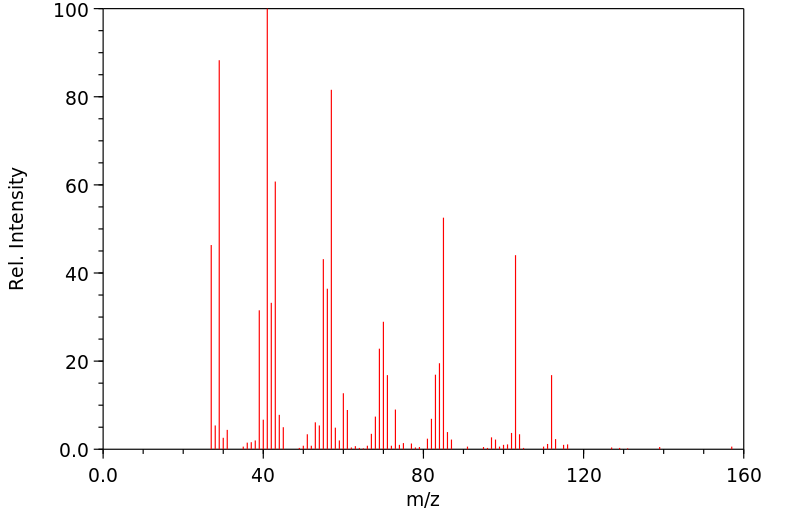戊酸辛酯 | 5451-85-4
中文名称
戊酸辛酯
中文别名
——
英文名称
octyl pentanoate
英文别名
pentanoic acid octyl ester;Octyl valerate
CAS
5451-85-4
化学式
C13H26O2
mdl
——
分子量
214.348
InChiKey
OUYCCOBIJYUMAK-UHFFFAOYSA-N
BEILSTEIN
——
EINECS
——
-
物化性质
-
计算性质
-
ADMET
-
安全信息
-
SDS
-
制备方法与用途
-
上下游信息
-
文献信息
-
表征谱图
-
同类化合物
-
相关功能分类
-
相关结构分类
物化性质
-
熔点:-42.3°C
-
沸点:261.6°C
-
密度:0.8615
-
LogP:5.371 (est)
-
保留指数:1474
计算性质
-
辛醇/水分配系数(LogP):4.8
-
重原子数:15
-
可旋转键数:11
-
环数:0.0
-
sp3杂化的碳原子比例:0.92
-
拓扑面积:26.3
-
氢给体数:0
-
氢受体数:2
安全信息
-
海关编码:2915600000
SDS
上下游信息
-
上游原料
中文名称 英文名称 CAS号 化学式 分子量 戊酸甲酯 methyl valerate 624-24-8 C6H12O2 116.16
反应信息
-
作为产物:参考文献:名称:纳米胶束在水中实现脂肪酶催化的酯化。1 锅多步序列的应用摘要:水性胶束介质中的酯化反应由市售脂肪酶在不存在任何辅因子的情况下催化。仅 2 wt% 设计表面活性剂 TPGS-750-M 的存在有助于 100% 选择性酶促过程,其中仅伯醇参与(与羧酸的比例为 1:1)。还公开了一个意想不到的发现,其中简单的添加剂PhCF 3 (相对于底物1当量)似乎显着扩展了可用酸/醇组合的范围。综上所述,现在可以在水中进行几种化学和生物催化的一锅多步骤反应。DOI:10.1039/d1sc05660c
文献信息
-
Facile oxidative conversion of alcohols to esters using molecular iodine作者:Naoshi Mori、Hideo TogoDOI:10.1016/j.tet.2005.03.097日期:2005.6A simple, efficient, and high-yield procedure for the oxidative conversion of alcohols to various types of esters and ketones, with molecular iodine and potassium carbonate was successfully carried out.
-
Process for Production of Alkyl Tin Alkoxide Compound, and Process for Production of Carbonic Acid Ester Using the Compound申请人:Shinohata Masaaki公开号:US20100292496A1公开(公告)日:2010-11-18The present invention provides a process for producing: a compound represented by XOR 2 ; a dialkyl tin dialkoxide compound having one tin atom, two Sn—R 1 bonds and two Sn—OR 2 bonds; and/or a tetraalkyl dialkoxy distannoxane compound having one Sn—O—Sn bond, in which each tin atom of the tetraalkyl dialkoxy distannoxane compound has two Sn—R 1 bonds and one Sn—OR 2 bond, the process comprising reacting in the absence of a catalyst at least one alkyl tin compound selected from the group consisting of i) and ii) below: i) a dialkyl tin compound having one tin atom, two Sn—R 1 (wherein R 1 represents an alkyl group) bonds, and two Sn—OX bonds (wherein OX is a group in which HOX that is a conjugate acid of OX is a Bronsted acid having a pKa of from 0 to 6.8); and ii) a tetraalkyl distannoxane compound having one Sn—O—Sn bond, in which each tin atom of the tetraalkyl distannoxane compound has two Sn—R 1 bonds and one Sn—OX bond (wherein OX is a group in which HOX that is a conjugate acid of OX is a Bronsted acid having a pKa of from 0 to 6.8); and a carbonic acid ester represented by R 2 OCOOR 2 (wherein R 2 represents a linear or branched, saturated or unsaturated hydrocarbon group, a hydrocarbon group having a saturated or unsaturated cyclic hydrocarbon substituent, or a Y—CH 2 — group (wherein Y represents an alkyl polyalkylene group, an aromatic group or a cyclic saturated or unsaturated alkylene ether group)), and/or an alcohol represented by R 2 OH (wherein R 2 is the same as defined above).本发明提供了一种生产过程:产生一个由XOR表示的化合物;具有一个锡原子、两个Sn—R1键和两个Sn—OR2键的二烷基锡二烷氧化合物;和/或具有一个Sn—O—Sn键的四烷基二烷氧基二锡烷氧化合物,其中四烷基二烷氧基二锡烷氧化合物的每个锡原子具有两个Sn—R1键和一个Sn—OR2键,所述过程包括在缺乏催化剂的情况下反应以下所述组中选择的至少一种烷基锡化合物: i) 具有一个锡原子、两个Sn—R1(其中R1代表烷基基团)键和两个Sn—OX键(其中OX是HOX的共轭酸,HOX是具有从0到6.8的pKa的Bronsted酸的群)的二烷基锡化合物;和 ii) 具有一个Sn—O—Sn键的四烷基二锡烷氧化合物,其中四烷基二锡烷氧化合物的每个锡原子具有两个Sn—R1键和一个Sn—OX键(其中OX是HOX的共轭酸,HOX是具有从0到6.8的pKa的Bronsted酸的群);和 由R2OCOOR2(其中R2代表线性或支链、饱和或不饱和碳氢基团、具有饱和或不饱和环烃取代基的碳氢基团,或Y—CH2—基团(其中Y代表烷基多聚烯基基团、芳香基团或环状饱和或不饱和烷基醚基团))表示的碳酸酯;和/或 由R2OH(其中R2与上述定义相同)表示的醇。
-
[EN] PROCESSES FOR PRODUCING CARBOXYLIC ACIDS<br/>[FR] PROCÉDÉS DE PRODUCTION D'ACIDES CARBOXYLIQUES申请人:EASTMAN CHEM CO公开号:WO2020205348A1公开(公告)日:2020-10-08Processes are disclosed for preparing carboxylic acids from organic esters, the processes comprising contacting an ester with water in the presence of an acid catalyst and a homogenizing solvent at conditions effective to form a carboxylic acid. The homogenizing solvent is present in an amount sufficient to form a single-phase reaction mixture comprising the ester, water, and homogenizing solvent. The homogenizing solvent may be selected from acetonitrile, dimethyl sulfoxide, and 1,4-dioxane.
-
Transesterification of Methyl 2-Nitroacetate to Superior Esters作者:Massimo Corsi、Stefano Magnolfi、Fabrizio MachettiDOI:10.1002/ejoc.202000050日期:2020.3.22Methyl 2‐nitroacetate (MNA) is not as good as methyl acetoacetate (MAA) in giving transesterification reactions with alcohols. While MAA is capable of thermal transesterification without catalyst, MNA gives superior nitroacetates only with the use of a catalyst. Decomposition of MNA into CO2, CH3OH, and CH3NO2 should be prevented.
-
METHOD FOR PRODUCING ALCOHOL COMPOUND申请人:Hagiya Koji公开号:US20120010417A1公开(公告)日:2012-01-12A method for producing an alcohol compound, wherein a carboxylic acid ester compound is reduced with hydrogen in the presence of a ruthenium complex which is obtained by reacting an imidazolium salt (A) having at least one optionally substituted amino group with a ruthenium compound (B) in the presence of a base (C).
表征谱图
-
氢谱1HNMR
-
质谱MS
-
碳谱13CNMR
-
红外IR
-
拉曼Raman
-
峰位数据
-
峰位匹配
-
表征信息
同类化合物
(±)17,18-二HETE
(±)-辛酰肉碱氯化物
(Z)-5-辛烯甲酯
(Z)-4-辛烯酸
(R)-甲羟戊酸锂盐
(R)-普鲁前列素,游离酸
(R,R)-半乳糖苷
(E)-4-庚烯酸
(E)-4-壬烯酸
(E)-4-十一烯酸
(9Z,12E)-十八烷二烯酸甲酯
(6E)-8-甲基--6-壬烯酸甲基酯-d3
(3R,6S)-rel-8-[2-(3-呋喃基)-1,3-二氧戊环-2-基]-3-羟基-2,6-二甲基-4-辛酮
龙胆二糖
黑曲霉二糖
黄质霉素
麦芽酮糖一水合物
麦芽糖醇
麦芽糖酸
麦芽糖基蔗糖
麦芽糖一水合物
麦芽糖
鳄梨油酸乙酯
鲸蜡醇蓖麻油酸酯
鲸蜡醇油酸酯
鲸蜡硬脂醇硬脂酸酯
鲸蜡烯酸脂
鲸蜡基花生醇
鲫鱼酸
鲁比前列素
鲁比前列素
高级烷基C16-18-醇
高甲羟戊酸
高效氯氰菊酯
高-gamma-亚油酸
马来酸烯丙酯
马来酸氢异丙酯
马来酸氢异丁酯
马来酸氢丙酯
马来酸氢1-[2-(2-羟基乙氧基)乙基]酯
马来酸单乙酯
马来酸单丁酯
马来酸二辛酯
马来酸二癸酯
马来酸二甲酯
马来酸二烯丙酯
马来酸二正丙酯
马来酸二戊基酯
马来酸二异壬酯
马来酸二异丙酯







